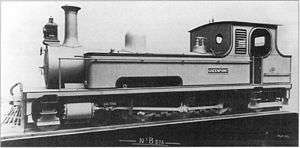1896 in South Africa
The following lists events that happened during 1896 in South Africa.
| |||||||||
| Decades: |
| ||||||||
|---|---|---|---|---|---|---|---|---|---|
| See also: | |||||||||
Incumbents
- Governor of the Cape of Good Hope and High Commissioner for Southern Africa:Hercules Robinson.
- Governor of the Colony of Natal: Charles Bullen Hugh Mitchell.
- State President of the Orange Free State: Pieter Jeremias Blignaut (until March 4), Martinus Theunis Steyn (starting March 4).
- State President of the South African Republic: Paul Kruger.
- Prime Minister of the Cape of Good Hope: Cecil John Rhodes (until January 13), John Gordon Sprigg (starting January 13).
- Prime Minister of the Colony of Natal: .
Events
- January
- 2 – Leander Starr Jameson and his forces surrender at Doornkop near Krugersdorp.
- 6 – Cecil Rhodes is forced to resign as Prime Minister of the Cape Colony for his involvement in the Jameson Raid.
- February
- 19 – A train carrying 56 tons of dynamite explodes at Braamfontein, Johannesburg, killing more than 78 people.[1]
- May
- 13 – The Franchise Bill is passed by Natal's Legislative Assembly, disfranchising natives of other countries.
- June
- August
- 6 – Cape Town's first electric tram service begins operation along Adderley Street to Mowbray Hill.
- December
- 18 – Mohandas Karamchand Gandhi arrives back in Durban with his wife and two sons, but the ship is placed under a 5-day quarantine because Bombay was declared a plague-infected port. Quarantine will later be extended to 13 January 1897.
- Unknown date
- South Africa's first school of mines is opened in Kimberley. It will later form the core of the University of the Witwatersrand in Johannesburg.
Births
- 12 January – Matthys Stefanus Benjamin Kritzinger, an Afrikaans literator and lexicographer, is born in the district of Carolina, Eastern Transvaal.
- 1 February – Stephanus Le Roux Marais, organist, teacher and composer of Afrikaans songs, is born in the district of Bloemfontein.
- 1 February – Ivan Mitford-Barberton, art teacher at the Michaelis School of Art in Cape Town and sculptor of several monuments in South Africa, is born in Somerset East.
- April – Clements Kadalie, trade unionist, is born at Chifira, Nkhata Bay District, Nyasaland (now Malawi).
- 3 May – Petrus Johannes Lemmer, composer of Afrikaans songs, is born in Hartbeesfontein, Transvaal.
Deaths
- 17 September – Nicholaas Waterboer, Griqua chief and eldest son of Andries Waterboer, dies in Griekwastad.
Railways
Railway lines opened
- 1 February – Cape Eastern – Sterkstroom to Indwe, 67 miles (107.8 kilometres).[2]
- 1 April – Transvaal – Kaapmuiden to Barberton, 34 miles (54.7 kilometres).[2]
- 2 November – Transvaal – Krugersdorp to Frederikstad, 52 miles (83.7 kilometres).[2]
Locomotives
- Cape
- Two new Cape gauge locomotive types enter service on the Cape Government Railways (CGR):
- The first of a second batch of fifty 6th Class 4-6-0 steam locomotives. In 1912 they would be designated Class 6A on the South African Railways (SAR).[3][4]
- The first of a second batch of forty-six 7th Class 4-8-0 Mastodon type locomotives on the Midland and Eastern Systems. In 1912 they would be designated Class 7A on the SAR.[3][4]
- Two 4-6-2 Pacific type tank locomotives enter service on the Metropolitan and Suburban Railway that operates a suburban passenger service between Cape Town and Sea Point.[3]
- Free State
- The Oranje-Vrijstaat Gouwerment-Spoorwegen places the first of twenty-four new Cape 6th Class 4-6-0 steam locomotives in service. In 1912 they would be designated Class 6C on the SAR.[3][4]
- Natal
- The Natal Government Railways (NGR) rebuilds one of its Class G 4-6-0 tank locomotives to the first 4-6-4 Baltic type locomotive in the world. It was later designated the NGR Class H.[3][4]
- Transvaal
gollark: I may have been somewhat unclear. I need a server for server-y uses (it runs my RSS reader and website and accursed personal integration scripts and such). This is currently a tower server, but for reasons I'd like a more compact thing.
gollark: I need to store backups and Linux ISOs and my giant datasets of memes and such.
gollark: I see.
gollark: I was wondering if there was something like the mini PC category, but with more ability to add disks.
gollark: Old servers tend to be quite good apart from largeness and power draw. There are lots of old mini PCs with good CPUs but seemingly poor disk expansion opportunities.
References
- The Great Dynamite Explosion, report by Mr. J.G. Blumberg, Fairmount School, Johannesburg, excerpt from the autobiography of Dutch immigrant Jan de Veer who came to South Africa in 1893.
- Statement Showing, in Chronological Order, the Date of Opening and the Mileage of Each Section of Railway, Statement No. 19, p. 183, ref. no. 200954-13
- Holland, D.F. (1971). Steam Locomotives of the South African Railways. 1: 1859–1910 (1st ed.). Newton Abbott, Devon: David & Charles. pp. 41–46, 57, 76–77, 83, 87–89, 108, 118–119, 126, 133. ISBN 978-0-7153-5382-0.
- Paxton, Leith; Bourne, David (1985). Locomotives of the South African Railways (1st ed.). Cape Town: Struik. pp. 23–24, 28–29, 41–44, 46–48. ISBN 0869772112.
This article is issued from Wikipedia. The text is licensed under Creative Commons - Attribution - Sharealike. Additional terms may apply for the media files.
.jpg)

